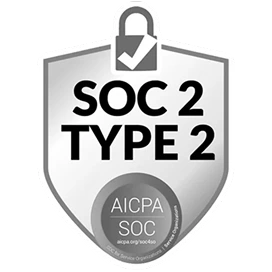Customer feedback plays a huge role in shaping customer experience (CX) and retaining customers. The tricky part is that feedback usually comes in messy, unstructured formats, such as support tickets, surveys, reviews, or even social media comments, which are tough to analyze on a large scale.
Feedback analytics tools solve this by turning raw text into clear insights you can use to fix issues, cut churn, and improve your product.
When teams start exploring their options, Thematic and Chattermill are two tools that come up again and again. Both rely on AI to spot patterns in feedback, highlight trends, and help businesses respond quickly.
Still, they approach the task differently, and those differences can affect which tool fits best.
In this article, we’ll compare Thematic and Chattermill, outline their pros and cons, and explain why many companies now see SentiSum as a more suitable choice for in-depth, actionable insights to reduce churn in real-time.
Thematic vs Chattermill vs SentiSum: A Comparison Table
What is Thematic
Thematic is a software platform that uses AI and natural language processing (NLP) to turn unstructured customer feedback into actionable insights.
Unstructured feedback means things like survey responses, support tickets, social media comments, reviews, basically any text that users write, which isn’t neatly formatted data.
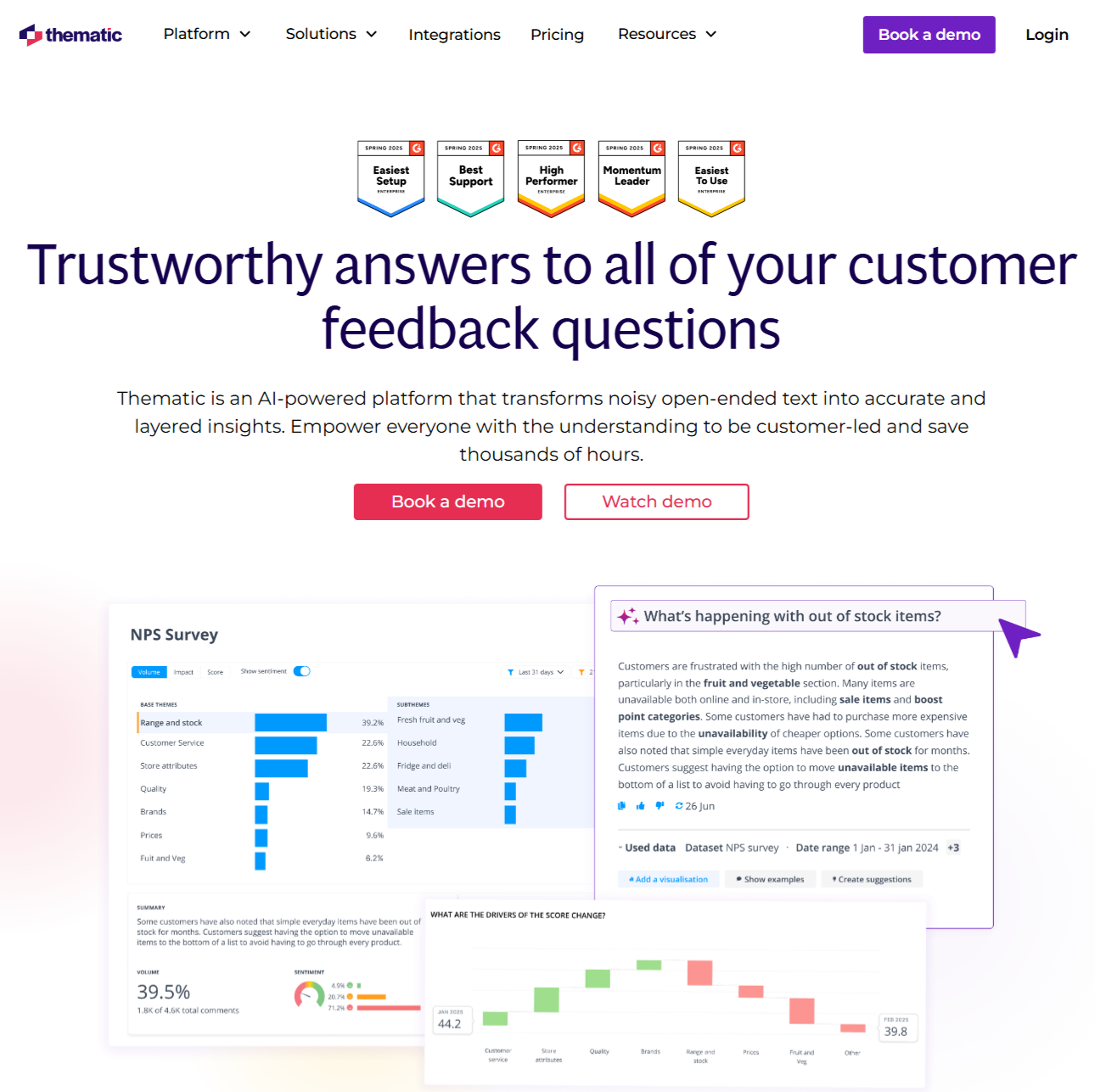
The goal is to help organizations listen to what customers are saying, in large volumes, without having to read every comment manually.
Thematic does the heavy lifting by detecting patterns (themes), measuring sentiment (whether things are positive, negative, or neutral), and surfacing what matters most so teams (product, customer experience, operations, etc.) can act faster.
You can pull feedback from various sources (surveys, chat, support tickets, reviews, etc.), feed it into Thematic, and then use dashboards, filters, and editors to refine the AI's findings. It also supports editing themes to ensure the output aligns with your business's values.
Key Thematic Features
Here are the core features of Thematic:
- Automated Theme Detection and Hierarchy: Thematic groups feed back into base themes and sub-themes. Base themes are broad topics, and sub-themes are more specific topics under them. This provides structure and allows you to zoom in or out as needed.
- Sentiment Analysis: Thematic doesn’t just tell you what people are talking about; it tells you how they feel about those topics. This helps prioritize what to fix or improve, based on the strength of the sentiment.
- Universal Data Source Integration and Data Shape-Handling: You can feed feedback from many channels, surveys, support tickets, reviews, social media and Thematic handles them. If the data isn’t in a perfect format, Thematic reshapes it. That flexibility makes it easier to roll out across an organization.
- Filtering, Drilling Down and Theme Editing: Once themes are created, you can filter by sentiment, date, channel, region, theme, etc., and see raw feedback. You can also edit or merge themes, ignore ones, and tailor them to your business’s context. That helps avoid misinterpretations or irrelevant themes.
- Reporting & Insight Sharing: Thematic provides dashboards, visualizations, exports, and tools to share insights with stakeholders. You can push alerts when specific feedback arises (e.g, product bugs, customer issues), which helps teams stay aligned.
Thematic Strengths
- Intuitive Interface and Easy to Use: Thematic offers an intuitive interface, advanced text analytics, and proper reporting. Making theme creation and qualitative data quantification seamless.
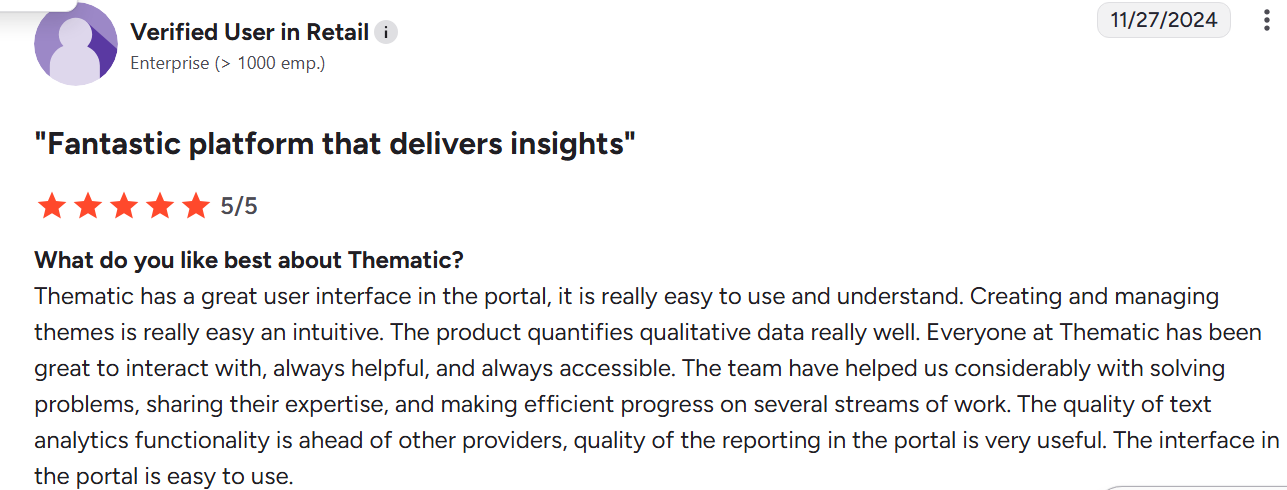
- Actionable Insights from Unstructured Feedback: Reviewers appreciate how Thematic turns open-ended text (surveys, feedback, tickets) into usable themes and sentiment. It helps identify what to fix or prioritize.
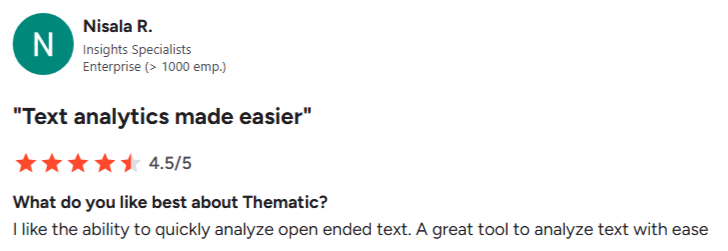
- Responsive Customer Support: Several reviews mention that Thematic’s support/customer success teams are helpful, responsive, and collaborative.

Thematic Limitations
- High Cost for SMEs: Thematic can feel expensive for small teams, and full value requires upgrading to higher pricing tiers.
- Learning curve for beginners: The Initial setup requires client effort to train the software on keywords and data grouping, needing ongoing updates.

- Inaccurate Themes: Some users struggle to correct incorrect themes, and NPS/Sentiment scores don’t always align with the actual tone of feedback.

What is Chattermill
Chattermill is a Voice-of-Customer (VoC) and customer feedback analytics platform that uses AI and machine learning to turn lots of unstructured feedback (surveys, product reviews, support tickets, social media, voice and chat conversations, etc.) into actionable, strategic insight.
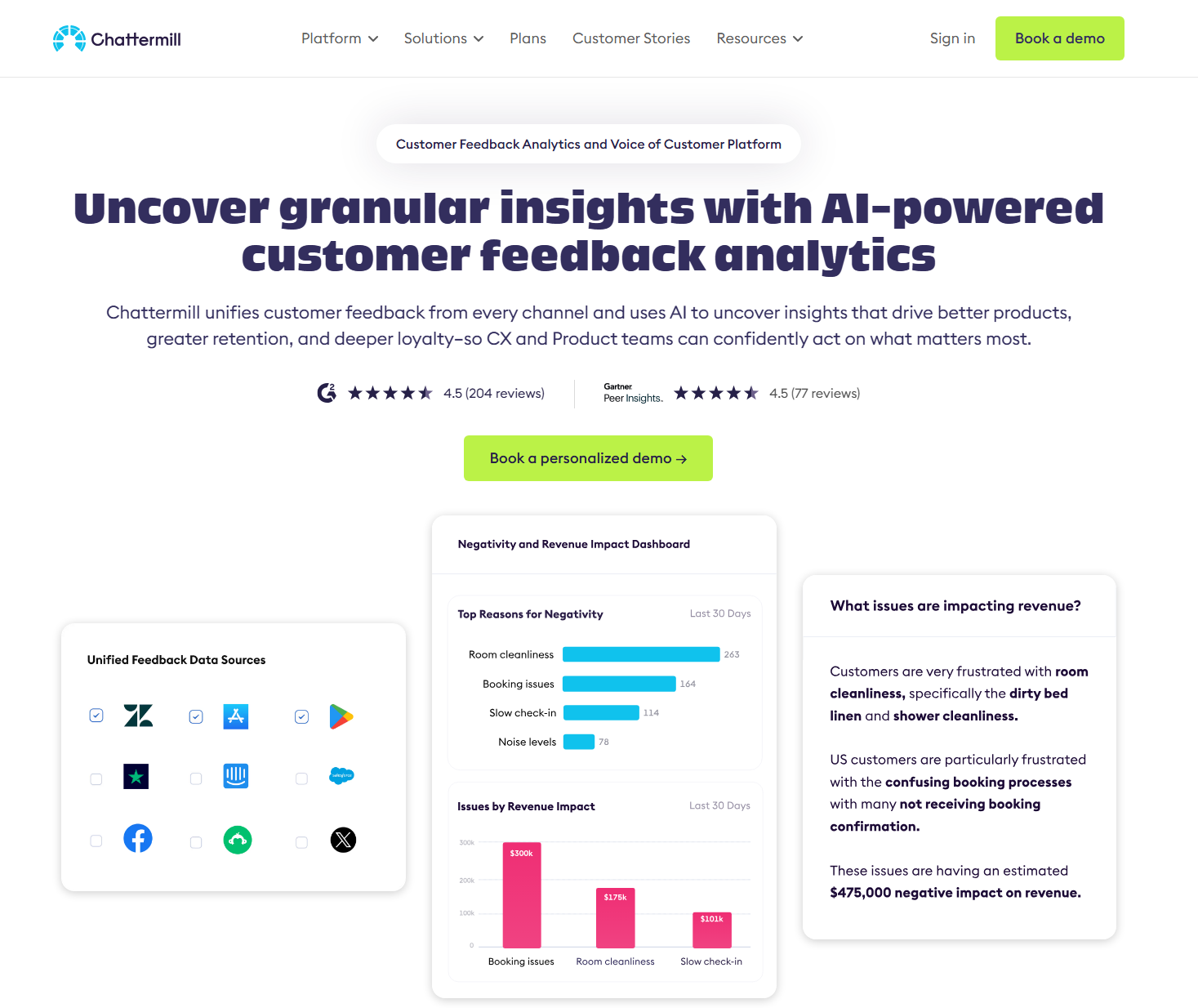
It unifies feedback across all channels, enabling organizations to gain a holistic view of customer feedback.
It doesn’t stop at data collection; it automatically tags themes, identifies sentiment (positive, negative, neutral), surfaces trends and anomalies, and connects what customers say with business metrics.
Key Chattermill Features
Here are standout features of Chattermill, ones that users and product teams tend to value highly.
- Lyra AI, Automated Theme and Sentiment Tagging: Chattermill uses its proprietary AI engine (Lyra) to process unstructured text at scale. It automatically categorizes feedback into themes/categories, detects sentiment, and picks up mixed sentiments in a single comment, among other features. This removes much of the manual work of reading and tagging feedback.
- Unified Feedback from Multiple Channels: You can pull in feedback from surveys, review sites, social media, support tickets, voice calls, and chat transcripts, all in different languages. This gives a more complete, cross-channel picture.
- Anomaly & Trend Detection with Alerts: Chattermill helps spot “what’s changing” patterns, shifts, emerging issues and triggers alerts when key metrics or sentiments deviate. This lets teams respond proactively rather than after things go wrong.
- Custom Dashboards, Segmentation, & Reporting: You can filter and segment feedback by metadata (region, product type, customer type, channel, etc.), build dashboards tailored for different teams, and see how metrics like NPS/CSAT correlate with underlying themes. You can share reports, export views, and more.
Chattermill Strengths
- Advanced NLP, Sentiment, and Thematic Analysis: Chattermill excels at automatically tagging themes, detecting sentiment, and uncovering patterns in large volumes of unstructured feedback. This eliminates the need for manual comment sorting and helps teams quickly understand customer perceptions.
- Comprehensive Feedback Coverage: The platform consolidates data from surveys, support tickets, live chats, emails, and even voice interactions. By unifying these sources into a single system, Chattermill ensures teams can prioritize issues and identify opportunities with greater clarity.
- Real-Time Alerts and Workflow Integration: Chattermill doesn’t just analyze, it enables action. Real-time alerts flag sentiment shifts or threshold breaches, empowering teams to respond immediately. This operational focus helps businesses move beyond reporting to proactive customer experience management.
Chattermill Limitation
- Learning Curve and Usability: Getting started with Chattermill isn’t easy. The dashboard feels complex, and setting up filters or themes takes extra effort for non-technical users.

- Customization Constraints: Several users note that customization remains limited. Requests commonly include more advanced reporting, refined filtering, greater control over theme and sentiment definitions, and additional flexibility to tailor outputs to business-specific needs.
- Cost Considerations: Pricing is a recurring concern, particularly for mid-sized organizations. Reviewers highlight that costs can feel relatively high.
Thematic vs Chattermill Pricing
Here are the pricing details of the tools:
Thematic Pricing
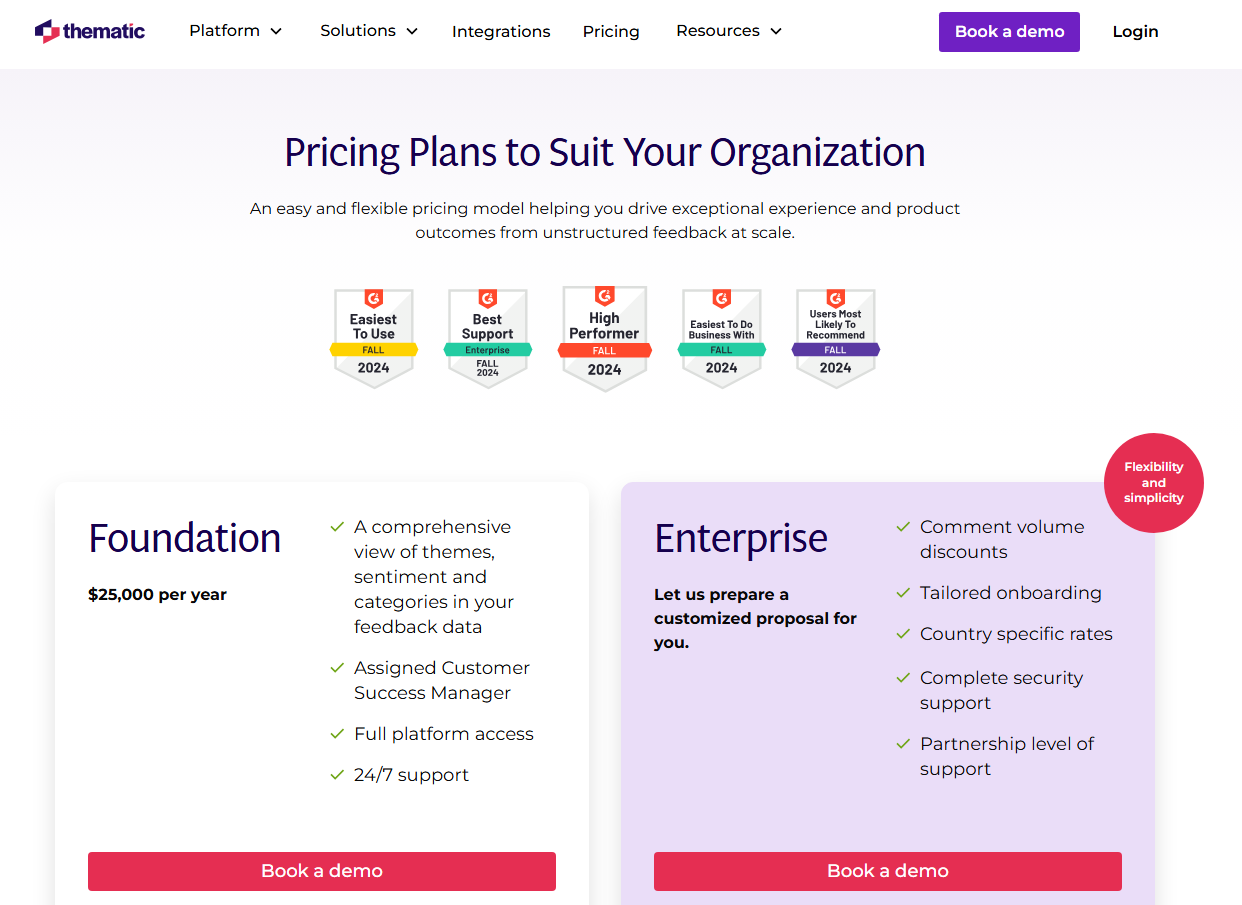
Thematic offers two pricing plans:
- Foundation costs $25,000 per year and includes up to 25,000 comments, three datasets, advanced analysis tools, dashboards, workflows, and 24/7 support, plus a dedicated Customer Success Manager.
- Enterprise pricing is customized, with volume discounts, tailored onboarding, country-specific rates, advanced security, and partnership-level support. Both plans provide full access to thematic and sentiment analysis, reporting, integrations, and natural language features like Thematic Answers.
Chattermill Pricing

Chattermill offers three plans based on feedback volume and data sources. You need to contact their support to get tailored pricing.
- Pro includes two integrations, 10,000 data credits per month, unlimited sharing, and translations.
- Team builds on Pro with three integrations, 30,000 credits, historical data analysis, and growth tools.
- Enterprise adds five integrations, 100,000 credits, custom roles, and data rollover.
All plans include unlimited users, dashboards, customizable filters, anomaly detection, onboarding, a dedicated Success Manager, and enterprise-level security.
How SentiSum Outperforms Thematic and Chattermill
Thematic and Chattermill both do a solid job of surfacing themes and sentiment, but they tend to focus on categorization and reporting. SentiSum, on the other hand, focuses on preventing churn by converting feedback into real-time retention actions.
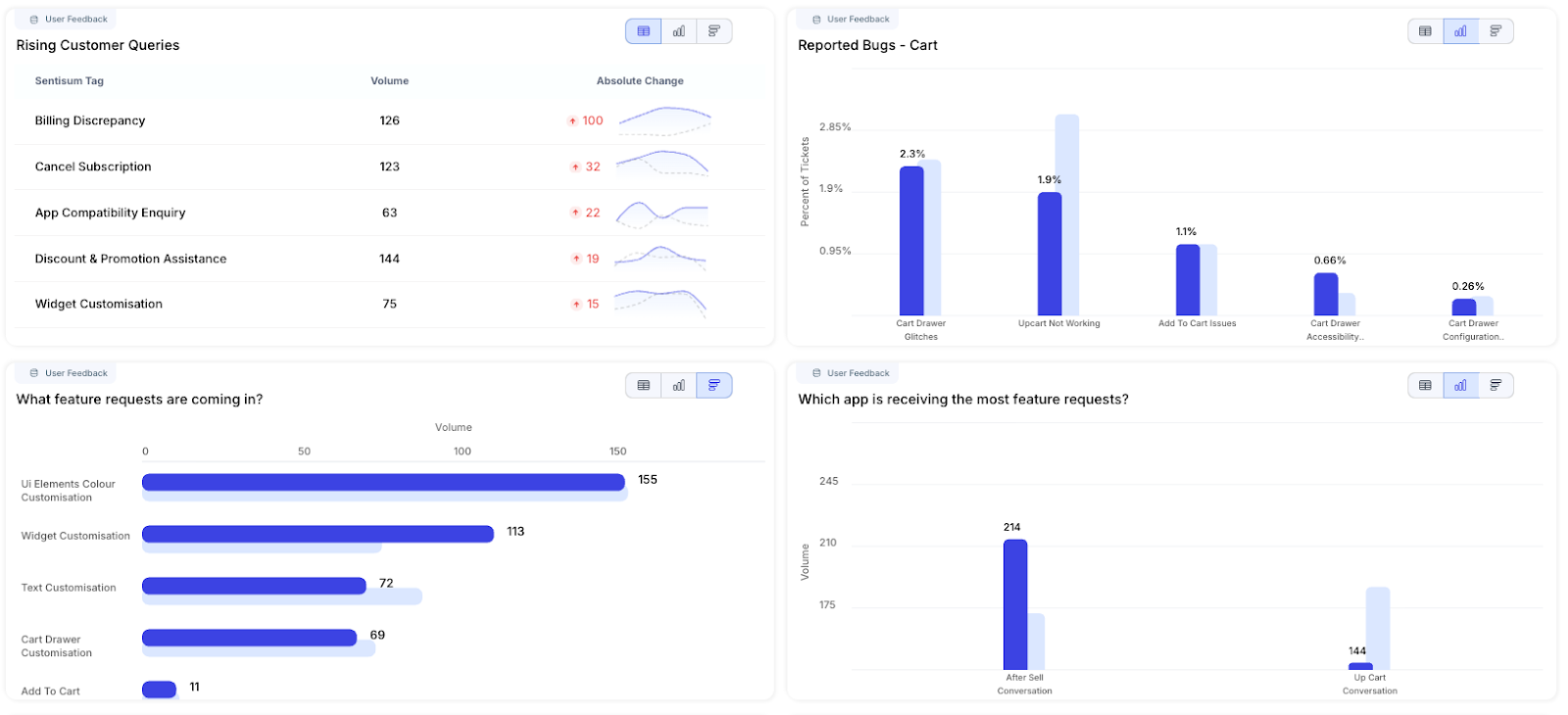
Purpose-built to deliver real-time churn detection for subscription-based businesses, SentiSum ingests all your unstructured feedback, including support tickets, live chat logs, reviews, surveys, and emails. Then it uses real-time AI to uncover what customers are unhappy about, which ones are likely to leave, and what exactly you should do to keep them.
Key Strengths of SentiSum
Kyo: Your AI Agent for Retention
Kyo doesn’t just identify issues; it also spots which customers are at risk of leaving and suggests specific actions to retain them.

You’ll know immediately when there’s a surge in trouble topics like delivery delays, confusing UX, or billing bugs.
Real-Time AI Analysis & Alerting
Feedback isn’t stored and forgotten; it gets analyzed as it comes in. The system constantly tags and classifies feedback using AI that handles nuance, so new issues or shifts in sentiment don’t slip through.
You get alerted when unusual patterns emerge before a minor issue becomes a churn problem.
Unified View Across All Channels
All your reviews, surveys, chats, emails, and social feedback flow into SentiSum. Your dashboard puts every touchpoint in one view, helping you avoid blind spots.
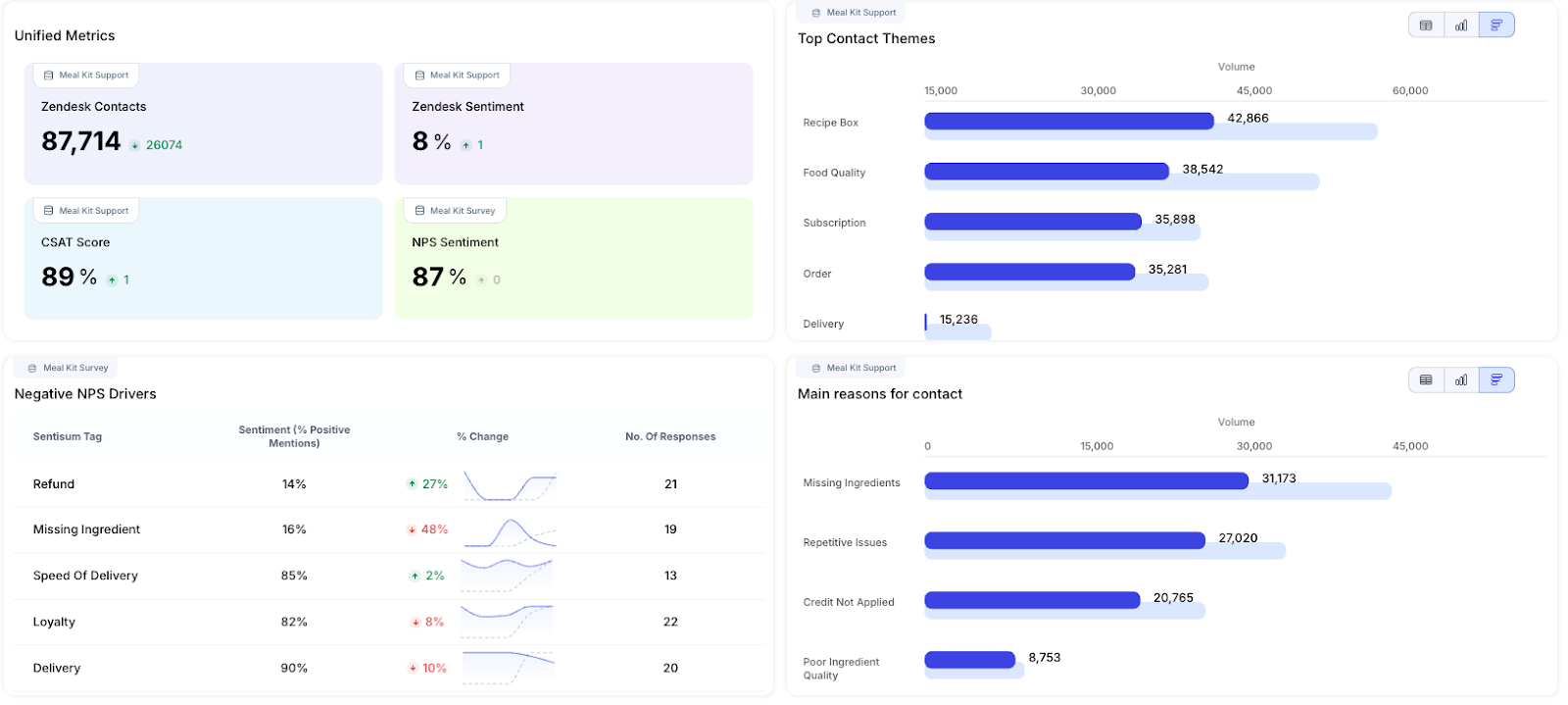
If one channel has issues like rising product returns or negative reviews, you’ll see it alongside support tickets, giving you a complete picture of your customer experience.
Automated Tagging, Prioritization & Triage
Every interaction is automatically tagged with detailed topics like “account cancellation,” “feature requests,” or “product defect,” with sentiment. Then, essential issues can be prioritized or routed automatically. If sentiment drops or topic frequency spikes, you don’t need to wait for someone to notice it’s pushed to where action needs to happen.
Fast Setup, High Adoption
It integrates with systems you already use (Zendesk, Freshdesk, Intercom, Gorgias, etc.), making rollout smoother. You don’t need massive upfront setup or manual tagging schemes. The tag taxonomy is maintained and updated as customer language evolves. Teams start using it quickly.
Root Cause and Actionable Insights
SentiSum goes beyond telling you what is happening. It helps you understand why and gives you suggestions for what to do next.
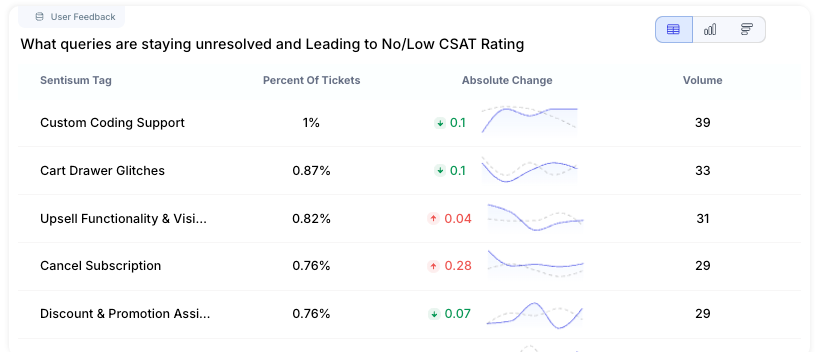
Whether it’s highlighting which feature is causing complaints or which customer segment is showing early signs of churn, you get guidance so teams can intervene early.
Case Study: How Butternut Box Uses SentiSum to Boost Retention
SentiSum vs Thematic vs Chattermill: Which Tool Best Fits Which Situation?
Choosing between SentiSum, Thematic, and Chattermill depends on your organization’s feedback volume, data sources, and business priorities.
Thematic – Ideal for small to mid-sized, support-heavy teams
Thematic excels at analyzing support tickets, chat logs, CSAT surveys, and NPS responses. Its strength lies in customizable theme detection and AI output refinement, allowing teams to extract meaningful insights without getting overwhelmed. If you need detailed analysis of surveys or tailored insights for specific business contexts, Thematic’s intuitive reporting and editing flexibility provide a practical edge.
Chattermill – Best for large enterprises handling cross-channel feedback
Chattermill’s Lyra AI engine scales effortlessly across surveys, reviews, social media, and call transcripts. It detects anomalies, tracks trends, and ties insights to business metrics, making it ideal for organizations prioritizing breadth over granular theme editing. The trade-off is a steeper learning curve and higher cost.
SentiSum – For teams focused on actionable outcomes
SentiSum’s AI agent, Kyo, goes beyond classification. It highlights anomalies, detects churn risks, and recommends next-best actions in real time.
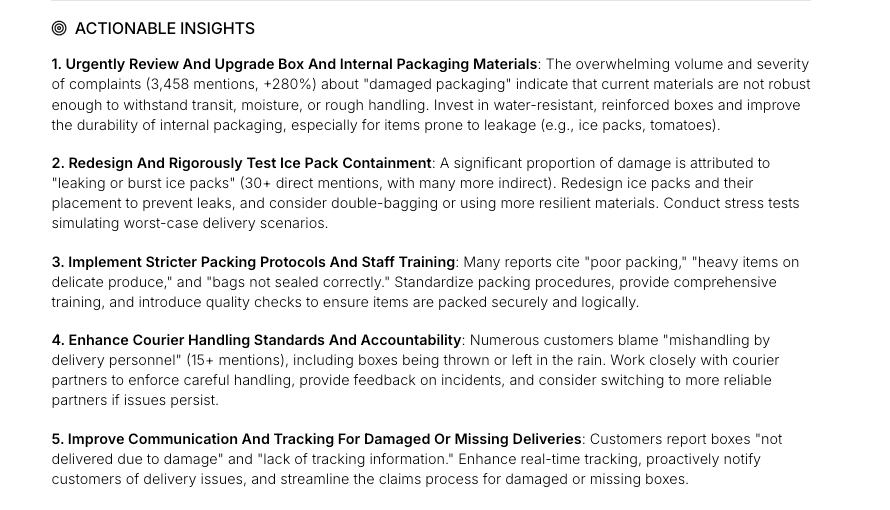
This makes SentiSum the top choice for organizations aiming to improve retention, drive loyalty, and act quickly on customer signals. For teams serious about turning feedback into business impact, SentiSum delivers measurable results.
Stop Losing Customers to Preventable Issues with SentiSum
Thematic and Chattermill provide strong feedback analysis with AI-driven theme detection and sentiment insights. However, their focus often stops at categorization and reporting.
As an AI-native VoC platform, SentiSum takes it a step further, transforming unstructured feedback into real-time, retention-focused actions that directly reduce churn and boost loyalty.
With Kyo, its AI agent, you’ll know what issues pose the highest risk and the exact steps to take. For teams serious about using feedback to drive measurable business outcomes, SentiSum stands out as the more intelligent choice.
Book a demo today to see how SentiSum turns feedback into retention actions.
Heading 1
Heading 2
Heading 3
Heading 4
Heading 5
Heading 6
Lorem ipsum dolor sit amet, consectetur adipiscing elit, sed do eiusmod tempor incididunt ut labore et dolore magna aliqua. Ut enim ad minim veniam, quis nostrud exercitation ullamco laboris nisi ut aliquip ex ea commodo consequat. Duis aute irure dolor in reprehenderit in voluptate velit esse cillum dolore eu fugiat nulla pariatur.
Block quote
Ordered list
- Item 1
- Item 2
- Item 3
Unordered list
- Item A
- Item B
- Item C
Bold text
Emphasis
Superscript
Subscript

.webp)
.png)





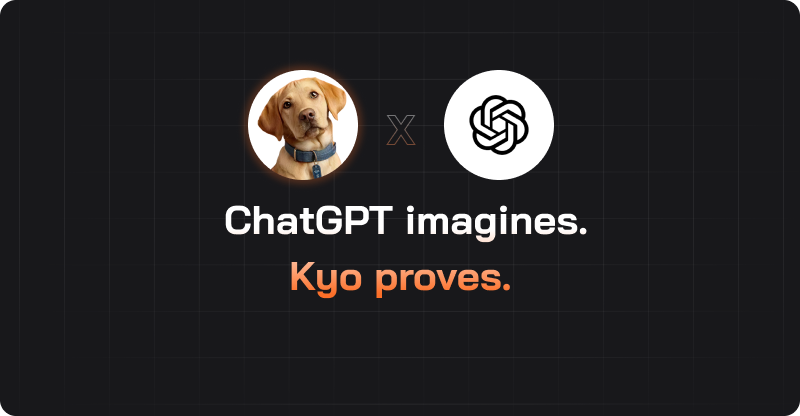
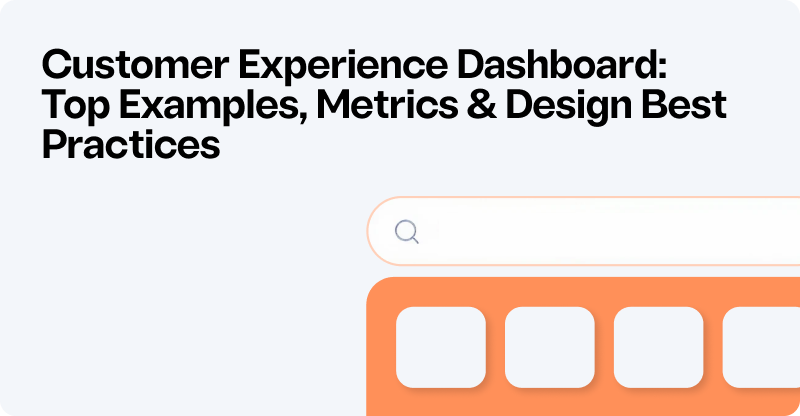

.webp)

.svg)










